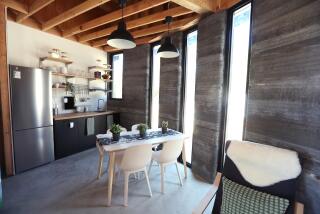Middlebury solar house turns green design into a liberal art
- Share via
What might be the most unorthodox team in the 2013 Solar Decathlon comes from Middlebury College in Vermont. The institution with about 2,500 students doesn’t have graduate programs, so no engineering or architecture school, and all of its team members study liberal arts -- think English or economics. Developing a Solar Decathlon house is part of a two-semester, interdepartmental class.
“We approach this problem from a very different point of reference,” said team manager Jack Kerby-Miller, who majors in environmental studies and chemistry.
The Middlebury students are some of the competition’s most dogmatic about across-the-board sustainability, not mere technical efficacy. Sure, their home is green, but they emphasize that it’s also socially and economically effective. Two-thirds of the house is communal space, valuing public over private usage. Materials were locally sourced or manufactured. Wood was reclaimed from New England barns, floors were harvested from maples on campus, and steel was manufactured by a local company.
PHOTOS: Middlebury College solar house artist renderings
Other U.S.-based Solar Decathlon teams trucked their prefab structures to the competition site in Orange County, but Middlebury took its house apart and shipped the components via train in containers. That lowered the team’s carbon footprint by two-thirds, it said.
“We have to be really organized to make this system work,” Kerby-Miller said of his team, which put the house together twice on campus before the decathlon. “We know it’s going to take a long time to assemble, but we’re not stressed.”
The squad’s nontraditional thinking also informed the design. Instead of the traditional rooftop solar array, the team conceived an exterior walkway shaded by photovoltaic panels. The walkway isn’t just a nice outdoor spot, the team members said. It’s intended to draw people toward the house so they learn more about it.
FULL COVERAGE: Solar Decathlon 2013
A more familiar sustainable element is the green roof, which contributes thermal mass, sucks carbon and helps to reduce storm water runoff. To protect the house from Vermont’s extreme weather shifts, the house has 14-inch-thick walls and a 28-inch-thick ceiling, both insulated with cellulose. The team used denim to insulate seams between panels.
After the competition, the Middlebury Solar Decathlon house will return to campus, where it will serve as student housing.
JOIN THE CONVERSATION:@latimeshome | pinterest.com/latimeshome | facebook.com/latimeshome | facebook.com/latimesgarden
More to Read
Inside the business of entertainment
The Wide Shot brings you news, analysis and insights on everything from streaming wars to production — and what it all means for the future.
You may occasionally receive promotional content from the Los Angeles Times.










